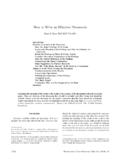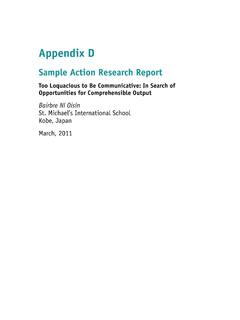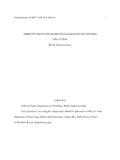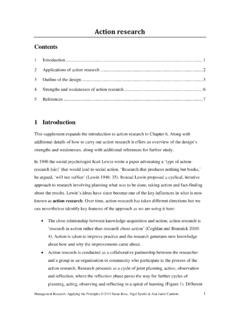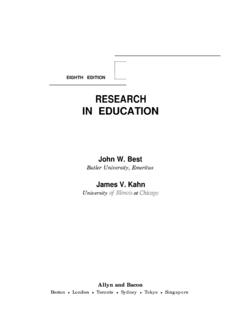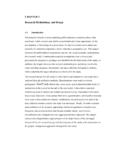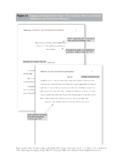Transcription of How to Write the Methods Section of a Research …
1 How to Write the Methods Section of a Research Paper Richard H Kallet MSc RRT FAARC. Introduction Basic Research Concepts Content and Writing Style of the Methods Section Subjects Ethical Considerations Preparations Protocol Design Measurements and Calculations Data Analysis Summary The Methods Section of a Research paper provides the information by which a study's validity is judged. Therefore, it requires a clear and precise description of how an experiment was done, and the rationale for why specific experimental procedures were chosen. The Methods Section should describe what was done to answer the Research question, describe how it was done, justify the experimental design, and explain how the results were analyzed.
2 Scientific writing is direct and orderly. Therefore, the Methods Section structure should: describe the materials used in the study, explain how the materials were prepared for the study, describe the Research protocol, explain how measure- ments were made and what calculations were performed, and state which statistical tests were done to analyze the data. Once all elements of the Methods Section are written, subsequent drafts should focus on how to present those elements as clearly and logically as possibly. The description of preparations, measurements, and the protocol should be organized chronologi- cally.
3 For clarity, when a large amount of detail must be presented, information should be presented in sub-sections according to topic. Material in each Section should be organized by topic from most to least important. Key words: publications; Research ; Research methodology;. clinical trials; laboratory Research ; writing; mauscripts, medical. [Respir Care 2004;49(10):1229 1232. 2004 Daedalus Enterprises]. Introduction the validity of a study is ultimately judged. Therefore, the author must provide a clear and precise description of how The Methods Section is the most important aspect of a an experiment was done, and the rationale for the specific Research paper because it provides the information by which experimental procedures chosen.
4 It must be written with enough information so that: (1) the experiment could be repeated by others to evaluate whether the results are re- Richard H Kallet MSc RRT FAARC is affiliated with the Cardiovascular producible, and (2) the audience can judge whether the Research Institute, and with Respiratory Care Services, Department of Anesthesia, San Francisco General Hospital, University of California, results and conclusions are valid. In this article I describe San Francisco, California. Richard H Kallet MS RRT FAARC presented a version of this article at the RESPIRATORY CARE Journal symposium, Anatomy of a Research Correspondence: Richard H Kallet MS RRT FAARC, Respiratory Care Paper: Science Writing 101, at the 48th International Respiratory Con- Services, San Francisco General Hospital, NH:GA-2, 1001 Potrero Av- gress, held October 5 8, 2002, in Tampa, Florida.
5 Enue, San Francisco CA. 94110. E-mail: RESPIRATORY CARE OCTOBER 2004 VOL 49 NO 10 1229. HOW TO Write THE Methods Section OF A Research PAPER. one approach to writing the Methods Section . Because this to emphasize that confounding variables can never be fully Section is so intimately related to the principles of scien- controlled. Furthermore, the influence of these variables tific Research , I begin with a review of basic Research may not be fully appreciated by those conducting the re- concepts, and then follow with a discussion of important search. External validity is primarily determined by how points to incorporate when writing the Methods Section .
6 Subjects are selected to participate in a study and by the use of randomization procedures that limit potential bias in how subjects are assigned to treatment groups. Basic Research Concepts Content and Writing Style of the Methods Section The scientific method attempts to discover cause-and- effect relationships between objects (ie, physical matter or Historically, the Methods Section was referred to as the processes). In the physical sciences objects are regarded as materials and Methods to emphasize the 2 distinct areas variables, and a variable is anything that can assume dif- that must be addressed.
7 Materials referred to what was ferent values. Elucidating a cause-and-effect relationship examined (eg, humans, animals, tissue preparations) and between objects requires that variables are classified as also to the various treatments (eg, drugs, gases) and in- independent, dependent, or confounding. An independent struments (eg, ventilators) used in the study. Methods . variable is one that, when manipulated, causes a change in referred to how subjects or objects were manipulated to another variable. The variable that changes in response to answer the experimental question, how measurements and that manipulation is referred to as a dependent variable.
8 Calculations were made, and how the data were analyzed. For example, arterial oxygen tension is a dependent vari- The complexity of scientific inquiry necessitates that able that responds to manipulations in independent vari- the writing of the Methods be clear and orderly to avoid ables such as barometric pressure and oxygen concentra- confusion and ambiguity. First, it is usually helpful to tion. A confounding or extraneous variable is anything structure the Methods Section by: other than the independent variable of interest that may 1. Describing the materials used in the study affect the dependent variable.
9 Therefore, a change in a 2. Explaining how the materials were prepared dependent variable may be due wholly or in part to a 3. Describing the Research protocol change in a confounding variable. For example, a change 4. Explaining how measurements were made and what in minute ventilation can alter arterial oxygen tension by calculations were performed its effect upon alveolar carbon dioxide partial pressure. 5. Stating which statistical tests were done to analyze Evaluation of a potential cause-effect relationship be- the data2. tween 2 objects is accomplished through the development Second, the writing should be direct and precise and in of the study design.
10 A study design is simply a strategy to the past tense. Compound sentence structures should be control and manipulate variables that provide an answer to avoided, as well as descriptions of unimportant details. the Research question regarding potential cause-and-effect Once all elements of the Methods Section are written down relationships. during the initial draft, subsequent drafts should focus on Validity refers to the credibility of experimental results how to present those elements as clearly and logically as and the degree to which the results can be applied to the possibly.
